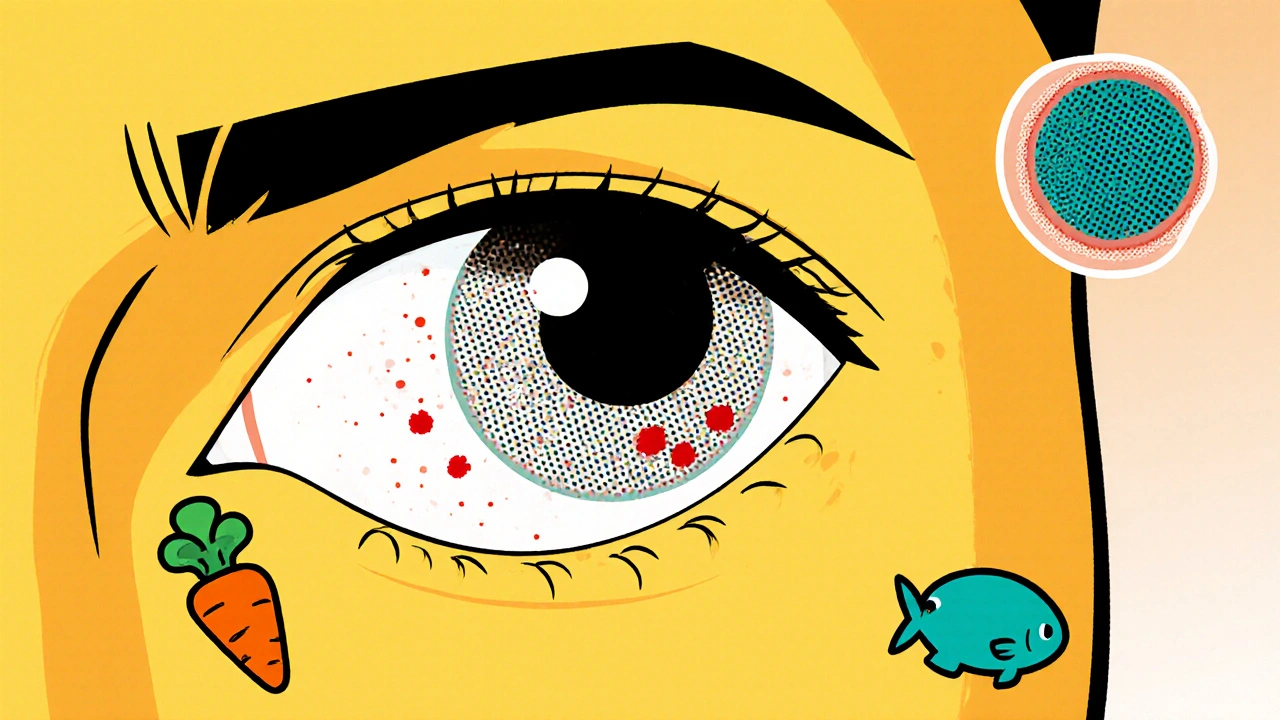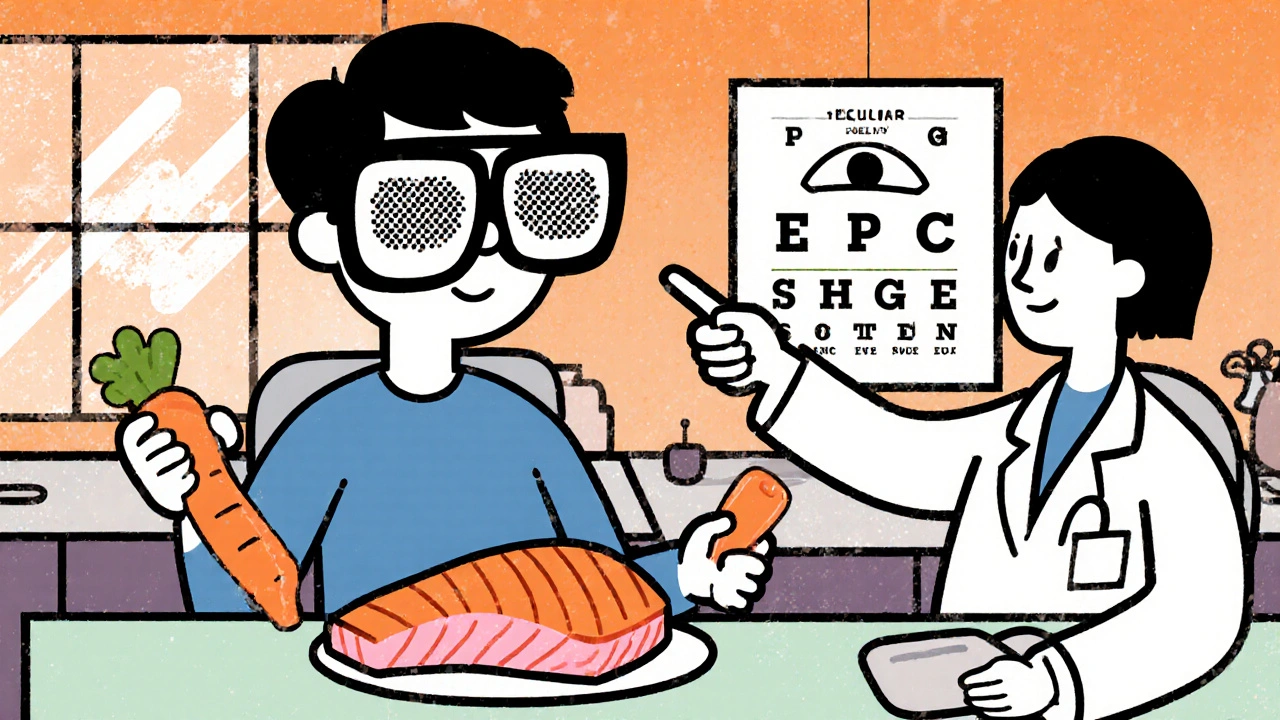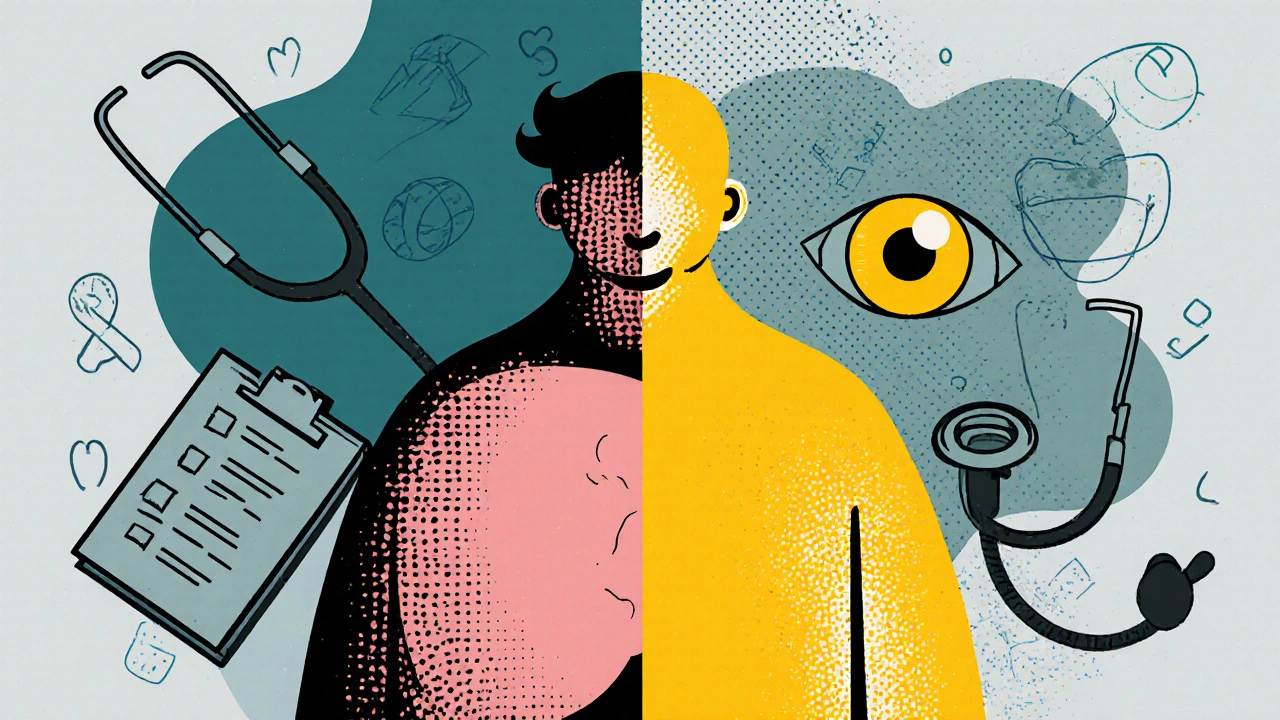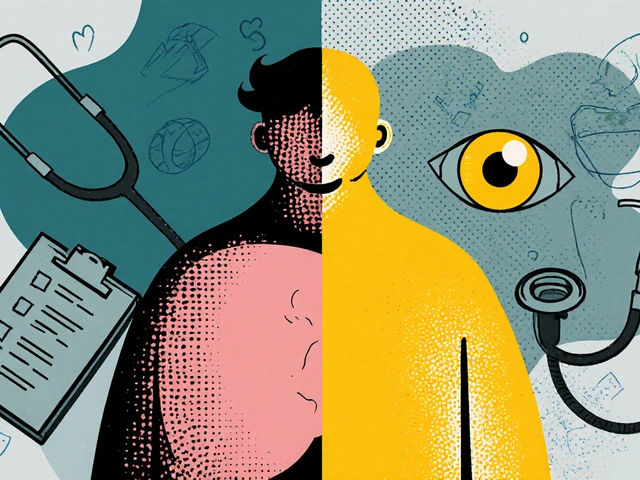Vitamin A Deficiency Risk Calculator
Assess Your Vitamin A Deficiency Risk
Liver disease can lead to vitamin A deficiency, which affects night vision and eye health. This tool estimates your risk based on your liver condition.
Your Vitamin A Deficiency Risk
Ever noticed that your eyes look a little off when you’re feeling really sick? It’s not just coincidence - the liver and the eyes are more connected than most people realize. When liver failure strikes, it can send warning signs straight to your vision.
What is Liver Failure?
Liver Failure is the inability of the liver to perform essential functions such as detoxifying blood, producing clotting factors, and storing nutrients. It can be acute (sudden) or chronic (developing over years due to cirrhosis, hepatitis, or fatty liver disease). Once the organ’s capacity falls below 10‑15% of normal, the body starts showing systemic symptoms, many of which affect the eyes.
How the Liver Talks to Your Eyes
Three main pathways link a failing liver to eye problems:
- Bilirubin overload: When the liver can’t process bilirubin, it builds up in the blood, turning the whites of the eyes yellow (jaundice). High bilirubin also deposits in retinal tissues, leading to blurred vision.
- Vitamin A deficiency: The liver stores 80‑90% of the body’s vitamin A. Liver damage releases less of this vitamin, and without enough vitamin A, the retina can’t form the pigment rhodopsin, which is critical for night vision.
- Systemic inflammation & toxin buildup: Toxins that would normally be cleared linger, irritating the ocular surface and increasing intra‑ocular pressure, which can trigger glaucoma.
Key Ocular Symptoms to Watch
Not every patient will see all these signs, but they’re common enough to keep on your radar:
| Symptom | Typical Stage of Liver Failure | Underlying Cause |
|---|---|---|
| Yellow sclera (jaundice) | Early to moderate | Elevated bilirubin |
| Dry eye / gritty sensation | Moderate | Reduced tear film quality from systemic inflammation |
| Retinal hemorrhages | Advanced | Coagulopathy and portal hypertension |
| Glaucoma‑like pressure spikes | Advanced | Inflammatory cytokines affecting aqueous humor outflow |
| Night‑vision loss | Any stage with vitamin A deficiency | Depleted vitamin A stores |
Why These Symptoms Appear
Let’s break down the science behind the most frequent eye issues.
- Bilirubin is a yellow pigment produced by the breakdown of red blood cells. When the liver can’t conjugate it, bilirubin circulates and settles in ocular tissues, making the sclera appear yellow and sometimes causing fleeting visual disturbances.
- Vitamin A deficiency leads to poor regeneration of rhodopsin, the visual pigment needed for low‑light vision. Patients report difficulty reading at night or driving in dim conditions.
- Retinal hemorrhage stems from impaired clotting factor production and portal hypertension causing fragile retinal vessels to rupture. These appear as red spots on fundoscopic exams.
- Dry eye results from reduced tear secretion triggered by systemic inflammation and medication side‑effects. The ocular surface becomes irritated, leading to a gritty feeling.
- Glaucoma can be secondary to increased intra‑ocular pressure caused by inflammatory cytokines that block the trabecular meshwork. If untreated, it can cause irreversible peripheral vision loss.

Who Is Most at Risk?
Anyone with chronic liver disease-whether from alcohol‑related cirrhosis, hepatitis B/C, non‑alcoholic fatty liver disease (NAFLD), or genetic disorders-should keep an eye on their vision. Acute liver failure from drug toxicity (e.g., acetaminophen overdose) can produce rapid ocular changes within days.
How to Get Your Eyes Checked
Regular ophthalmic exams become crucial once liver disease is diagnosed. Here’s a quick checklist for patients and clinicians:
- Baseline slit‑lamp exam to assess the cornea, conjunctiva, and tear film.
- Fundoscopic evaluation for retinal hemorrhages or papilledema.
- Intra‑ocular pressure measurement, especially if the patient reports headaches or peripheral vision loss.
- Night‑vision testing (e.g., low‑light visual acuity charts) to catch early vitamin A deficiency.
- Blood work correlation: bilirubin, albumin, INR, and vitamin A levels.
Managing Eye Health While Dealing With Liver Failure
Even if the liver isn’t fully functional, you can still protect your eyes:
- Nutrition first: Incorporate foods rich in vitamin A (carrots, sweet potatoes, spinach) and omega‑3 fatty acids (salmon, flaxseed) to support retinal health.
- Stay hydrated: Adequate fluid intake helps maintain tear film quality.
- Limit medications that dry the eyes: Some diuretics and antihistamines exacerbate dry‑eye symptoms; discuss alternatives with your doctor.
- Use preservative‑free artificial tears several times a day if you feel gritty.
- Protect against UV light with sunglasses that block 99‑100% UVA/UVB; UV can speed up cataract formation, already more common in chronic liver patients.
- Regular follow‑up with both hepatology and ophthalmology teams. Coordination ensures that any worsening ocular sign triggers a reassessment of liver status.

When to Seek Immediate Care
Some eye problems demand urgent attention:
- Sudden loss of vision in one eye - could be retinal artery occlusion.
- Severe eye pain with redness - may indicate acute glaucoma.
- Rapid increase in yellowing of the sclera combined with confusion - could signal hepatic encephalopathy worsening.
- Frequent, unexplained floaters or flashing lights - sign of retinal hemorrhage or detachment.
Bottom Line
While a failing liver is a serious medical emergency, it also gives the eyes a front‑row seat to the body’s internal turmoil. Recognizing jaundice, dry‑eye sensations, night‑vision loss, or retinal bleeding can act as early alarms, prompting quicker medical intervention. By staying proactive with eye exams, nutrition, and open communication between liver specialists and eye doctors, patients can preserve their vision even as they battle liver disease.
Frequently Asked Questions
Can liver failure cause permanent blindness?
Permanent blindness is rare, but untreated secondary glaucoma or repeated retinal hemorrhages can lead to irreversible vision loss. Early detection and treatment dramatically reduce this risk.
Why does my eye white turn yellow when my liver is sick?
The yellow hue is bilirubin depositing in the sclera. It’s one of the first visible signs of liver dysfunction.
Is vitamin A supplementation safe for people with liver disease?
Supplementation should only be done under a doctor’s guidance. Excess vitamin A can be toxic to an already stressed liver.
Do all liver patients need regular eye exams?
Yes. Even mild liver impairment can affect tear production and intra‑ocular pressure, so an annual comprehensive exam is advisable.
Can medications for liver disease worsen eye health?
Some drugs, like certain diuretics and beta‑blockers, can dry out the eyes or affect pressure. Your ophthalmologist can suggest lubricating drops or alternative dosing.



Drew Waggoner
October 18, 2025 AT 21:52The thought of losing sight when your liver quits is chilling.
Mike Hamilton
October 22, 2025 AT 23:35When the liver stops working the body sends signals to the eyes. This is kind of like a warning light on a car. You might notice yellow whites or blurry vision. It reminds us that no organ works alone. Taking care of the liver can keep the eyes healthy, definately worth a checkup. Simple diets and regular doctor visits can save a lot of trouble.
Natala Storczyk
October 27, 2025 AT 01:18Oh, the agony of watching your world turn yellow, a jaundiced haze that screams “failure”!!! The liver’s betrayal is not just internal, it paints your eyes with sorrow, and the pain *feeds* on every glance. You feel the pressure rise, like a storm inside the skull, and the tears dry up, leaving a gritty desert on the surface!!! This is not a minor inconvenience, it is a battle for every photon that reaches the retina.
nitish sharma
October 31, 2025 AT 03:01It is essential to recognise that hepatic insufficiency often manifests ocularly, thereby offering clinicians an additional diagnostic avenue. Patients are encouraged to seek comprehensive ophthalmic evaluation concurrent with liver assessments. By maintaining vigilant monitoring, we can intervene early and preserve visual function. Let us therefore uphold a collaborative approach between hepatology and ophthalmology.
Rohit Sridhar
November 4, 2025 AT 04:43Living with liver disease can feel overwhelming, but understanding its impact on vision gives you a concrete way to act. First, know that bilirubin buildup is not just a cosmetic issue-it can actually cloud your sight, so keeping blood tests under control matters. Second, vitamin A stores are tied to the liver, so a diet rich in carrots, sweet potatoes, and leafy greens can boost night vision. Third, regular tear film assessments help catch dry‑eye symptoms before they become painful. Fourth, schedule a baseline fundus exam; any retinal hemorrhages spotted early are easier to manage. Fifth, keep an eye on intra‑ocular pressure, especially if you notice headaches or peripheral blurring. Sixth, stay hydrated-water supports both liver detoxification and tear production. Seventh, limit medications that dry the eyes, such as certain diuretics, and discuss alternatives with your physician. Eighth, consider preservative‑free artificial tears multiple times a day if you feel gritty; they are gentle on inflamed surfaces. Ninth, protect your eyes from UV light with high‑quality sunglasses; UV accelerates cataract formation, which is already more common in chronic liver patients. Tenth, incorporate omega‑3 fatty acids like salmon or flaxseed to nourish retinal cells. Eleventh, ask your healthcare team to coordinate liver function panels with ophthalmic findings; patterns often emerge that guide treatment. Twelfth, remember that early detection of secondary glaucoma can prevent irreversible vision loss, so never ignore pressure spikes. Thirteenth, maintain a supportive community-talking with others facing similar challenges can reduce stress, which in turn benefits liver health. Fourteenth, celebrate small victories, like a clearer night view after improving your vitamin A intake; these milestones reinforce healthy habits. Finally, stay proactive, keep up with appointments, and never underestimate the eyes as a window into your liver’s state.
Brian Van Horne
November 8, 2025 AT 06:26Indeed, this roadmap combines clinical precision with a splash of practical wisdom.
Norman Adams
November 12, 2025 AT 08:09Oh sure, because everyone has a spare hour to schedule extra eye exams while juggling Netflix marathons.
Margaret pope
November 16, 2025 AT 09:52Great points keep them in mind stay consistent and you’ll see improvement over time
Poornima Ganesan
November 20, 2025 AT 11:35Frankly, most patients ignore these ocular warnings until damage is irreversible; it’s a textbook example of neglecting basic medical advice.
Emma Williams
November 24, 2025 AT 13:18I agree with the emphasis on multidisciplinary care it really makes a difference
Stephanie Zaragoza
November 28, 2025 AT 15:00Indeed; the integration of hepatology and ophthalmology-when executed with rigor-significantly enhances early detection of retinal hemorrhages, thereby reducing morbidity.
Rajesh Singh
December 2, 2025 AT 16:43We ought to treat our bodies as sacred temples; neglecting the liver’s plea for care is a moral failing that inevitably stains our sight.
Bethany Torkelson
December 6, 2025 AT 18:26Stop dismissing liver‑related eye issues-they are real and demand immediate attention.